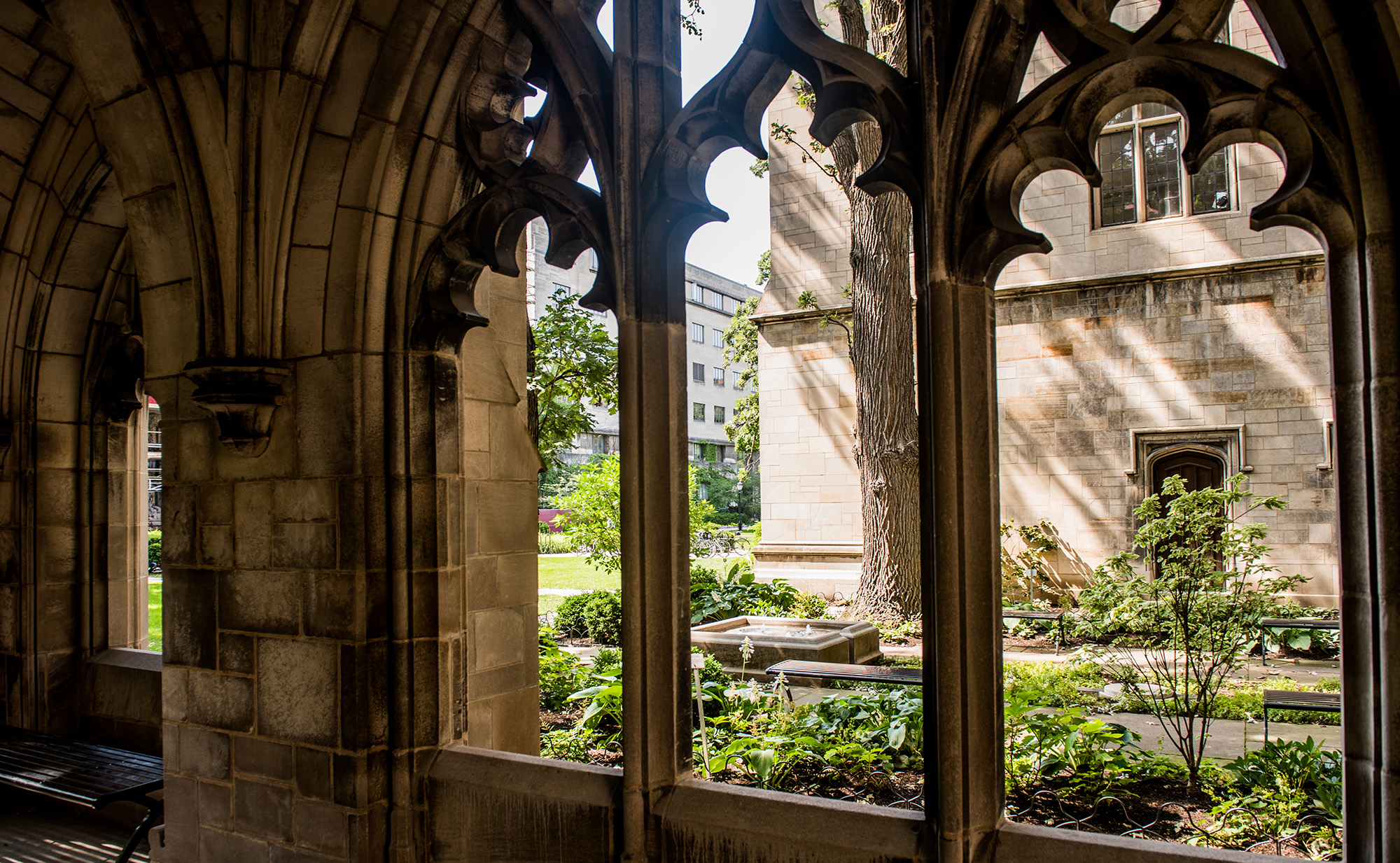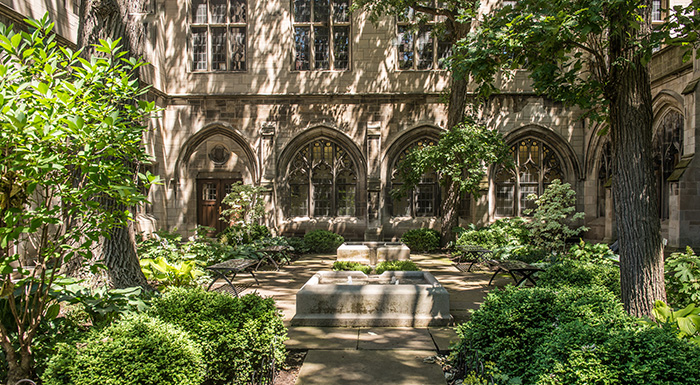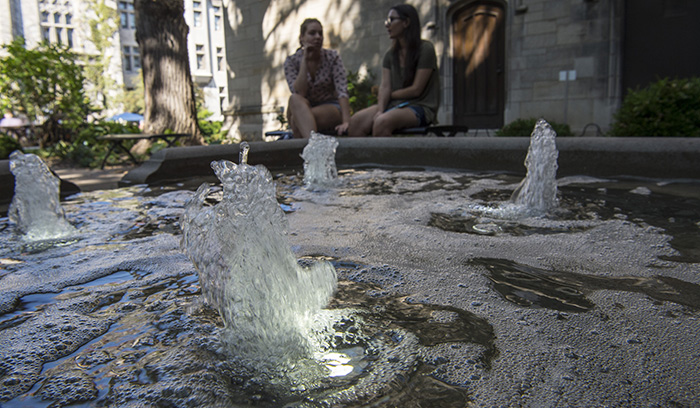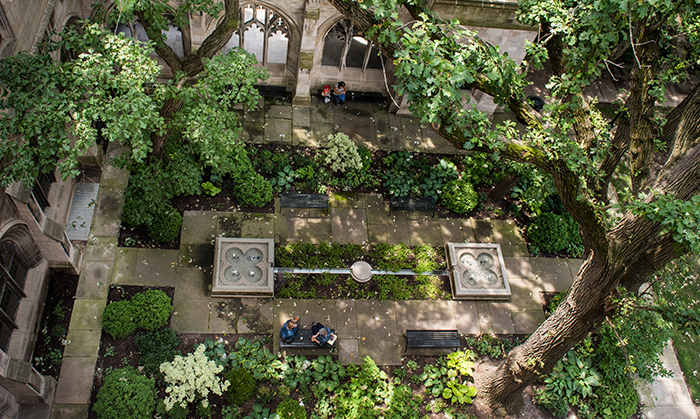
The Cloister garden outside Swift Hall, home to the Divinity School since 1925. (Photography by Jean Lachat)
Sometimes training for future pastors and chaplains looks a little like drama class.
“What does the wisdom of tradition you identify with … teach you about bodies?” Cynthia Lindner asks. The room fills with the sounds of clicking as students, who are all in the Master of Divinity (MDiv) program, answer the prompt on their laptops.
The 15 students in Lindner’s course, Arts of Religious Leadership and Practice: Spiritual Counseling, represent a range of traditions—both religious and nonreligious—and career ambitions. Liza wants to be a Lutheran pastor. Sarah is Jewish and is interested in chaplaincy; Austin, a Catholic, is training in chaplaincy as well. Chris, who has a background in organizing, considers Marxism his tradition. Tyler is enrolled in a joint program with the Law School.
Lindner, AM’80, DMin’99, the director of MDiv studies, is an ordained minister and licensed psychotherapist. She teaches the course, a required class for students in the school’s multireligious MDiv program, with two other UChicago alumni: Sunil K. Yadav, MDiv’16, a chaplain at Loyola University Medical Center; and Feryal Salem, AM’03, PhD’13, an associate professor at American Islamic College. The topic of today’s class is care for the sick.
The discussion swirls around different religions’ teachings about the body. In Christianity there’s the notion of the body of Christ. Of bodies “that were created good, but are subject to decay,” as Lilia says. In Judaism, there’s the importance of fasting and the notion that the body belongs to God.
In Islam “there’s a tripartite division between mind, body, and the spirit, which is embodied in the heart,” Salem says. Like Buddhism, Islam has the tradition of silent retreats: “deactivating hearing and seeing” to search for spiritual connection.
The readings for today include excerpts from The Wounded Storyteller: Body, Illness, and Ethics by Arthur W. Frank, Bipolar Faith: A Black Woman’s Journey with Depression and Faith by Monica A. Coleman, and The Cancer Journals by Audre Lorde.
All of them “are inviting us to occupy a particular form of listening,” Lindner says, because “our bodies themselves are inarticulate.” If you have ever been asked to rate your pain on a scale of 1 to 10, she says, you know the impossibility of communicating suffering with words, and how isolating that can be. How can you make someone else—a doctor, a family member, a friend—understand what kind of pain you’re experiencing?

After a break, it’s time for the practice labs—weekly exercises in giving and receiving care, based on actual caregiving encounters. The class divides into groups of four and decamps for smaller spaces in Swift Hall.
In each small group, one student will role-play a spiritual caregiver who leads a community support group. The other three students will play group members, who are seriously ill or dying.
Their life stages and prognoses are starkly different. There’s an older woman who is waiting for a liver transplant. A middle-aged woman—a cancer survivor with young children—who is dealing with a second cancer diagnosis. And a young man with just two weeks to live.
For the group that meets in Lindner’s colorful, book-filled office, the conversation is awkward and difficult. The young man rages about the life choices he’s made and wonders if he’s a good person. The middle-aged woman worries that she’s a terrible mother for abandoning her children.
“Thank you for sharing all these things,” says Lilia, who’s role-playing the care provider, when the allotted time is nearly up. “How about we all name one thing that we're looking forward to for the next week?”
Baking a pie with a friend, says the woman waiting on a liver transplant.
Seeing her kids in a play, says the woman with the new cancer diagnosis.
Hugging his parents, says the young man. They are coming to take care of him while he’s in hospice.

After the role-play, the small groups return to the classroom. Yadav—who usually runs the practice labs and the debrief afterward—asks how it went.
“Our good things were bad things,” Nate says: Tyler, as the care provider, had said something he immediately regretted afterward.
“I got the spiritual care provider again,” Tyler says. (Handouts with the character descriptions were passed out randomly; students did not get to choose.) “And I messed up again.” The rest of the class laughs. “It was the same thing Chris called me on last week, which was trying to solve problems … that’s how my brain works.”
The exercise is not just for the benefit of the care provider, though. For students assigned to role-play people who are sick or dying, it’s an exercise in radical empathy. “What does it mean to live like somebody whose liver is failing and has hepatitis?” Nate wonders. “Am I going to feel nauseous going to this meeting? How am I supposed to physically feel?”
Three-quarters of the students in the course had to inhabit that space emotionally, if not physically. But when Yadav asks what the experience was like, the room is silent.
“As a Buddhist and a chaplain, I can sit in silence for a while,” he says. “What do you think?”
The discussion circles around the uneven prognoses in the group and the struggle not to compare your own suffering to that of others. “It’s my instinct to do that,” Austin says, “and I loathe that.”
“What are you feeling when that relativism happens?” Yadav asks. He writes the words “empathic break” on the whiteboard.
In group situations, those who appear to be better off can feel sidelined: “‘You’re not listening to my suffering. You’re not hearing me out,’” Yadav says. When members of a group are “in different stages, empathic breaks happen quite a lot.”
How much should the care provider speak? Kylie tried paraphrasing back what each person said—but then realized that strategy meant everyone would speak only to her, and not to each other. So when someone said something and she wasn’t sure what to say, “I didn’t say anything.”
“Lilia was really good at holding the space,” Liza says, about the group that met in Lindner’s office. Role-playing the young man whose death was imminent, she felt like she could argue with the others: “like, ‘Screw you … I’m going to die in two weeks.’” Lilia made it feel comfortable to express those negative feelings, she says.
“The whole time, I was like, am I saying too little?” Lilia says.
“I can’t remember what your midpoint prompt was,” Liza says, “but you ended it by saying, ‘What is something you’re looking forward to in the week?’”
Because she had been able to express her character’s rage earlier in the discussion, Liza says, “I was able to find something good to say.”

Spiritual Care and Counseling is the second course of a required three-course sequence for the Master of Divinity program. “There's a lot of discomfort around this quarter,” Lindner says in an interview a few weeks later. “To put yourself in that space”—to attempt to embody the seriously ill or dying character described on your handout—“is really hard.”
Most of the time, we don’t want to think about “our mortality, our bodies, our vulnerability. So there are lots of reasons that the exercise feels awkward and uncomfortable,” she says, “especially in the context of an academically rigorous setting.” But by playing the opposite role, of someone who receives spiritual care, they will be better able to provide it.
When Lindner tells people what her job is, they’re often surprised that religious leaders have to be taught how to preach or give spiritual care; these practices are skills, not simply the province of gifted personalities. “Your doctor could cut up things before they went to school,” she says. “But you like the fact that they went to school to learn how to cut strategically and therapeutically.”
Practice sessions like this are critical to make sure students are aware of their own vulnerability and how to engage it to care for others. It’s a supportive space for students to struggle as they discover the challenges of offering care, she says, “because the next time—as chaplains or spiritual caregivers engaging their own fragility and that of their care receivers—the choices they make, and actions they take, won’t be without cost.”
